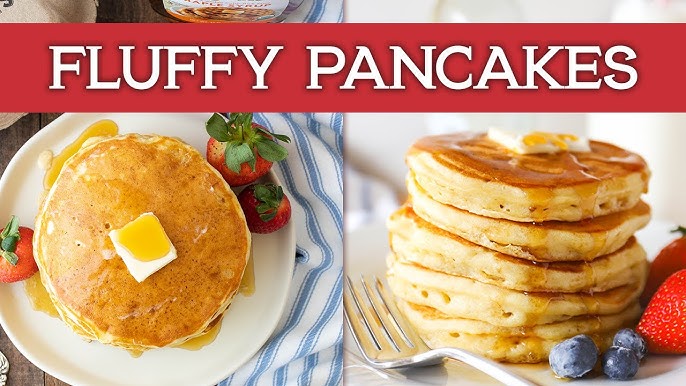Fluffy Pancake Recipe: Fluffy pancakes are a breakfast classic loved worldwide for their light, airy texture and delicious taste.
They’re the perfect comfort food for lazy mornings or special brunches. With a golden-brown outside and a soft, tender inside, they’re both easy to make and endlessly customizable.
This guide will take you through each step, ensuring your pancakes are perfectly fluffy and delicious.
Ingredients for Fluffy Pancakes
Before diving into the cooking process, gather all your ingredients to make it a smooth process. Here’s what you’ll need for basic, fluffy pancakes:
- 1 cup all-purpose flour
- 2 tablespoons sugar
- 1 teaspoon baking powder
- 1/2 teaspoon baking soda
- 1/4 teaspoon salt
- 3/4 cup milk (buttermilk works best)
- 1 large egg
- 2 tablespoons melted butter
- 1 teaspoon vanilla extract
For added flavor, consider including chocolate chips, blueberries, or a dash of cinnamon. Adjust quantities based on your preferences.
Essential Tools Needed
The right tools can make a big difference in achieving those perfectly fluffy pancakes:
- Large mixing bowls – one for dry ingredients and another for wet ingredients.
- Whisk – for thorough mixing without over-beating.
- Measuring cups and spoons – accurate measurement is key to consistency.
- Non-stick skillet or griddle – ensures pancakes cook evenly without sticking.
- Spatula – a thin spatula is ideal for flipping pancakes without breaking.
Step-by-Step Guide to Making Fluffy Pancakes
Follow each step carefully, as each is designed to maximize the fluffiness of your pancakes. Pancake-making is both an art and a science, and a few small tricks can make all the difference.
Step 1: Preparing the Dry Ingredients
To start, gather your dry ingredients and mix them in a large bowl.
- Measure and sift: Sift 1 cup of flour, 2 tablespoons of sugar, 1 teaspoon of baking powder, 1/2 teaspoon of baking soda, and 1/4 teaspoon of salt into a mixing bowl. Sifting removes lumps, resulting in a lighter, airier batter.
- Stir together: Use a whisk to combine the ingredients thoroughly. This step distributes the leavening agents evenly, which is essential for even fluffiness in the pancakes.
Step 2: Mixing Wet Ingredients Separately
In a separate bowl, it’s time to prepare your wet ingredients.
- Combine ingredients: Pour 3/4 cup milk, crack in 1 egg, add 2 tablespoons melted butter, and 1 teaspoon of vanilla extract.
- Whisk together: Mix until all ingredients are well-blended. The egg should be fully broken up, and the butter evenly distributed. Be careful not to over-mix, as this can affect the texture.
Step 3: Combining Wet and Dry Ingredients
Now, it’s time to bring everything together.
- Create a well in the dry ingredients: Make a small well in the center of the dry mixture and pour in the wet ingredients.
- Mix gently: Use a spatula or spoon to fold the wet ingredients into the dry mixture. Avoid over-mixing – some small lumps are fine. Over-mixing will activate gluten in the flour, which can make the pancakes dense.
Step 4: Letting the Batter Rest
Allowing your batter to rest is a small but significant step in ensuring maximum fluffiness.
- Let the batter sit for 5-10 minutes: This resting period allows the baking powder and baking soda to activate, forming air bubbles that will make your pancakes rise beautifully.
- Avoid stirring after the rest period, as this will deflate the batter.
Step 5: Heating the Pan Properly
A well-heated pan is essential for golden, fluffy pancakes.
- Choose the right pan: A non-stick skillet or griddle works best. Make sure the pan is large enough to hold a few pancakes at once without crowding.
- Heat on medium-low: Preheat the pan for about 5 minutes on medium-low heat. Pancakes cook best at a lower temperature to ensure they cook through without burning the outside.
Step 6: Pouring the Batter Correctly
Pouring the batter onto the pan might seem simple, but a few tips will help ensure even, round, fluffy pancakes.
- Use a measuring cup: A 1/4 cup measuring cup is ideal for scooping and pouring batter. This ensures all your pancakes are roughly the same size, which helps them cook evenly.
- Pour from a height: Pouring the batter from a slight height (about an inch above the pan) helps the pancake spread evenly.
- Avoid overcrowding: Leave enough space between each pancake so that they don’t merge. Each pancake should have room to expand slightly as it cooks.
Step 7: Cooking the Pancakes
Cooking time and technique are crucial for achieving that perfect fluffy pancake.
- Watch for bubbles: As the pancake cooks, bubbles will start to form on the surface. These bubbles are a key indicator of when it’s time to flip.
- Check edges: Besides the bubbles, the edges will start to firm up slightly. When the edges look set, it’s a sign the pancake is ready to flip.
- Adjust the heat if necessary: If the pancakes are browning too quickly on the bottom, reduce the heat slightly. Patience is key—cooking at a lower temperature ensures a tender, fully cooked center.
Step 8: Flipping Pancakes Perfectly
Flipping is an art! With a bit of practice, you’ll be flipping pancakes like a pro.
- Use a thin spatula: A thin, wide spatula slides easily under the pancake without breaking it.
- Flip with confidence: Slide the spatula under the pancake, lift it, and turn it over in one smooth motion. Try to flip only once to avoid deflating the pancake.
- Cook the other side: The second side will take less time to cook than the first—usually about 1 to 2 minutes. Check for a golden-brown color before removing it from the pan.
Step 9: Finishing Touches and Serving Suggestions
Once all your pancakes are cooked, it’s time to plate and add finishing touches.
- Stacking pancakes: Stack your pancakes on a plate for that classic breakfast look.
- Classic toppings: Drizzle with maple syrup, add a pat of butter, or sprinkle with powdered sugar.
- Get creative: Top with fresh fruit like blueberries, strawberries, or banana slices. Nut butters, honey, or a dollop of whipped cream can also add a delicious twist.
- Serve warm: Pancakes are best served immediately while warm. If you’re making a larger batch, keep them warm in a 200°F oven until ready to serve.
Tips for the Fluffiest Pancakes
To ensure your pancakes turn out light and fluffy every time, keep these tips in mind:
- Use buttermilk: Buttermilk adds a tangy flavor and a richer texture. If you don’t have buttermilk, create a substitute by mixing regular milk with a tablespoon of vinegar or lemon juice.
- Avoid over-mixing: Stir the batter just until the dry ingredients are incorporated. Over-mixing can lead to tougher pancakes.
- Rest the batter: Letting the batter rest for a few minutes gives time for the baking powder to create air bubbles, which makes the pancakes lighter.
- Don’t press down: Avoid pressing down on the pancakes with a spatula while cooking; this flattens them and reduces fluffiness.
Common Mistakes and How to Avoid Them
Even small missteps can affect the texture of your pancakes. Here are some common mistakes and tips to avoid them:
- Over-mixing the batter: As mentioned, too much stirring develops gluten in the flour, making pancakes chewy instead of tender. Mix until just combined.
- Cooking at too high a heat: High heat causes the outside to burn while leaving the inside undercooked. Stick to medium or medium-low heat for consistent results.
- Not using fresh leavening agents: Old baking powder or baking soda won’t rise as effectively, leading to flat pancakes. Make sure your leavening agents are fresh.
- Skipping the rest period: Resting allows the flour to absorb the liquid, creating a smoother texture and fluffier pancakes. Don’t skip this step.
FAQs about Fluffy Pancake Recipe
1. What ingredients are needed for fluffy pancakes?
To make fluffy pancakes, you’ll need basic ingredients like all-purpose flour, baking powder, sugar, salt, milk, eggs, and melted butter. These simple ingredients, combined with the right technique, will yield light and airy pancakes.
2. How can I make my pancakes extra fluffy?
The secret to extra fluffy pancakes is using baking powder and avoiding over-mixing the batter. Gently folding the ingredients keeps the batter airy, resulting in fluffier pancakes. Letting the batter rest for a few minutes before cooking can also improve the texture.
3. Should I use milk or buttermilk for fluffy pancakes?
Both milk and buttermilk work well, but buttermilk can add a tangy flavor and make the pancakes even fluffier. Buttermilk’s acidity reacts with baking powder, helping the pancakes rise more.
4. What is the best cooking temperature for fluffy pancakes?
Cook pancakes on medium heat to ensure they cook evenly without burning. Using a non-stick skillet or griddle can help achieve a golden-brown finish without sticking.
5. Can I make fluffy pancakes without eggs?
Yes, you can substitute eggs with alternatives like applesauce or yogurt. However, using eggs helps with structure and fluffiness, so the texture might differ slightly.
Conclusion
Making fluffy pancakes from scratch is a straightforward process, but small details make a huge difference in the final result. From sifting the flour to resting the batter and watching for bubbles, each step plays a role in creating that perfect pancake. With this guide, you’ll be able to make a stack of golden, airy pancakes that rival those from any breakfast diner. So gather your ingredients, heat up the skillet, and enjoy your homemade fluffy pancakes!
References
To ensure the quality and accuracy of our Fluffy Pancake Recipe, we’ve gathered insights from reputable sources. These trusted references provide additional details on pancake preparation techniques, ingredient choices, and tips for achieving the ideal fluffy texture. Explore the following links for further reading and to validate the information shared in this recipe:
- AllRecipes – Comprehensive pancake recipes with expert tips on getting a light, airy consistency.
- BBC Good Food – Step-by-step guidance on pancake techniques, from batter preparation to cooking.
- Food Network – Advice from top chefs on creating perfectly fluffy pancakes with alternative ingredients.
- Taste of Home – Practical tips for avoiding common pancake pitfalls and ensuring consistent results.
Feel free to explore these sources to enhance your pancake-making skills and enjoy consistently fluffy results!



